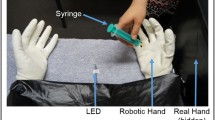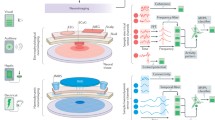Abstract
Neurofeedback training teaches individuals to modulate brain activity by providing real-time feedback and can be used for brain–computer interface control. The present study aimed to optimize training by maximizing engagement through goal-oriented task design. Participants were shown either a visual display or a robot, where each was manipulated using motor imagery (MI)-related electroencephalography signals. Those with the robot were instructed to quickly navigate grid spaces, as the potential for goal-oriented design to strengthen learning was central to our investigation. Both groups were hypothesized to show increased magnitude of these signals across 10 sessions, with the greatest gains being seen in those navigating the robot due to increased engagement. Participants demonstrated the predicted increase in magnitude, with no differentiation between hemispheres. Participants navigating the robot showed stronger left-hand MI increases than those with the computer display. This is likely due to success being reliant on maintaining strong MI-related signals. While older participants showed stronger signals in early sessions, this trend later reversed, suggesting greater natural proficiency but reduced flexibility. These results demonstrate capacity for modulating neurofeedback using MI over a series of training sessions, using tasks of varied design. Importantly, the more goal-oriented robot control task resulted in greater improvements.



Similar content being viewed by others
References
Akaike H (1974) A new look at the statistical model identification. IEEE Trans Automat Contr 19:716–723. doi:10.1109/TAC.1974.1100705
Bardouille T, Picton TW, Ross B (2010) Attention modulates beta oscillations during prolonged tactile stimulation. Eur J Neurosci 31:761–769. doi:10.1111/j.1460-9568.2010.07094.x
Boe S, Gionfriddo A, Kraeutner S et al (2014) Laterality of brain activity during motor imagery is modulated by the provision of source level neurofeedback. Neuroimage 101:159–167. doi:10.1016/j.neuroimage.2014.06.066
Braun S, Kleynen M, Schols J et al (2008) Using mental practice in stroke rehabilitation: a framework. Clin Rehabil 22:579–591. doi:10.1177/0269215508090066
Burianová H, Marstaller L, Sowman P et al (2013) Multimodal functional imaging of motor imagery using a novel paradigm. Neuroimage 71:50–58. doi:10.1016/j.neuroimage.2013.01.001
Deilami M, Jahandideh A, Kazemnejad Y et al (2016) The effect of neurofeedback therapy on reducing symptoms associated with attention deficit hyperactivity disorder: a case series study. Basic Clin Neurosci J. doi:10.15412/J.BCN.03070211
Donati ARC, Shokur S, Morya E et al (2016) Long-term training with a brain-machine interface-based gait protocol induces partial neurological recovery in paraplegic patients. Sci Rep 6:30383. doi:10.1038/srep30383
Farah MJ (1989) The neural basis of mental imagery. Trends Neurosci 12:395–399. doi:10.1016/0166-2236(89)90079-9
Gomez-Pilar J, Corralejo R, Nicolas-Alonso LF et al (2016) Neurofeedback training with a motor imagery-based BCI: neurocognitive improvements and EEG changes in the elderly. Med Biol Eng Comput. doi:10.1007/s11517-016-1454-4
Hamilton JP, Glover GH, Bagarinao E et al (2016) Effects of salience-network-node neurofeedback training on affective biases in major depressive disorder. Psychiatry Res 249:91–96. doi:10.1016/j.pscychresns.2016.01.016
Ietswaart M, Johnston M, Dijkerman HC et al (2011) Mental practice with motor imagery in stroke recovery: randomized controlled trial of efficacy. Brain 134:1373–1386. doi:10.1093/brain/awr077
Jeannerod M, Frak V (1999) Mental imaging of motor activity in humans. Curr Opin Neurobiol 9:735–739. doi:10.1016/S0959-4388(99)00038-0
Kober SE, Wood G, Kampl C et al (2014) Electrophysiological correlates of mental navigation in blind and sighted people. Behav Brain Res 273:106–115. doi:10.1016/j.bbr.2014.07.022
Kraeutner S, Gionfriddo A, Bardouille T, Boe S (2014) Motor imagery-based brain activity parallels that of motor execution: evidence from magnetic source imaging of cortical oscillations. Brain Res 1588:81–91. doi:10.1016/j.brainres.2014.09.001
Kraeutner S, Gionfriddo A, Bardouille T, Boe S (2014) Motor imagery-based brain activity parallels that of motor execution: evidence from magnetic source imaging of cortical oscillations. Brain Res 1588:81–91. doi:10.1016/j.brainres.2014.09.001
Ma L, Wang B, Narayana S et al (2010) Changes in regional activity are accompanied with changes in inter-regional connectivity during 4 weeks motor learning. Brain Res 1318:64–76. doi:10.1016/j.brainres.2009.12.073
Malouin F, Richards CL, Durand A, Doyon J (2009) Added value of mental practice combined with a small amount of physical practice on the relearning of rising and sitting post-stroke: a pilot study. J Neurol Phys Ther 33:195–202. doi:10.1097/NPT.0b013e3181c2112b
Masterpasqua F, Healey KN (2003) Neurofeedback in psychological practice. Prof Psychol Res Pract 34:652–656. doi:10.1037/0735-7028.34.6.652
Nunez P, Srinivasan R (1981) Electric fields of the brain: the neurophysics of EEG. Oxford University Press, Oxford
Oldfield RC (1971) The assessment and analysis of handedness: the Edinburgh inventory. Neuropsychologia 9:97–113
Peeters F, Oehlen M, Ronner J et al (2014) Neurofeedback as a treatment for major depressive disorder—a pilot study. PLoS ONE 9:e91837. doi:10.1371/journal.pone.0091837
Penhune VB, Doyon J (2005) Cerebellum and M1 interaction during early learning of timed motor sequences. Neuroimage 26:801–812. doi:10.1016/j.neuroimage.2005.02.041
Pfurtscheller G, da Silva FH (1999) Event-related {EEG}/{MEG} synchronization and desynchronization: basic principles. Clin Neurophysiol 110:1842–1857. doi:10.1016/S1388-2457(99)00141-8
Pfurtscheller G, Solis-Escalante T (2009) Could the beta rebound in the EEG be suitable to realize a “brain switch”? Clin Neurophysiol 120:24–29. doi:10.1016/j.clinph.2008.09.027
Pfurtscheller G, Neuper C, Brunner C, da Silva FL (2005) Beta rebound after different types of motor imagery in man. Neurosci Lett 378:156–159. doi:10.1016/j.neulet.2004.12.034
Picard N, Matsuzaka Y, Strick PL (2013) Extended practice of a motor skill is associated with reduced metabolic activity in M1. Nat Neurosci 16:1340–1347. doi:10.1038/nn.3477
Poldrack RA, Sabb FW, Foerde K et al (2005) The neural correlates of motor skill automaticity. J Neurosci 25:5356–5364. doi:10.1523/JNEUROSCI.3880-04.2005
Riccio I, Iolascon G, Barillari MR et al (2010) Mental practice is effective in upper limb recovery after stroke: a randomized single-blind cross-over study. Eur J Phys Rehabil Med 46:19–25
Schnitzler A, Salenius S, Salmelin R et al (1997) Involvement of primary motor cortex in motor imagery: a neuromagnetic study. Neuroimage 6:201–208. doi:10.1006/nimg.1997.0286
Schuster C, Butler J, Andrews B et al (2012) Comparison of embedded and added motor imagery training in patients after stroke: results of a randomised controlled pilot trial. Trials 13:11. doi:10.1186/1745-6215-13-11
Sousa T, Direito B, Lima J et al (2016) Control of brain activity in hMT +/V5 at three response levels using fMRI-based neurofeedback/BCI. PLoS ONE 11:e0155961. doi:10.1371/journal.pone.0155961
Toni I, Krams M, Turner R, Passingham RE (1998) The time course of changes during motor sequence learning: a whole-brain fMRI study. Neuroimage 8:50–61. doi:10.1006/nimg.1998.0349
Tremblay A, Tucker BV (2011) What can the production of four-word sequences tell us about the mental lexicon? Ment Lex 6:302–324
Ungerleider L (2002) Imaging brain plasticity during motor skill learning. Neurobiol Learn Mem 78:553–564. doi:10.1006/nlme.2002.4091
Wan F, da Cruz JN, Nan W et al (2016) Alpha neurofeedback training improves SSVEP-based BCI performance. J Neural Eng 13:36019. doi:10.1088/1741-2560/13/3/036019
Wiestler T, Diedrichsen J (2013) Skill learning strengthens cortical representations of motor sequences. Elife. doi:10.7554/eLife.00801
Xiong J, Ma L, Wang B et al (2009) Long-term motor training induced changes in regional cerebral blood flow in both task and resting states. Neuroimage 45:75–82. doi:10.1016/j.neuroimage.2008.11.016
Young KD, Zotev V, Phillips R et al (2014) Real-time FMRI neurofeedback training of amygdala activity in patients with major depressive disorder. PLoS ONE 9:e88785. doi:10.1371/journal.pone.0088785
Acknowledgements
We are grateful to the following people for their assistance in this study: Jack P. Solomon, Christopher Friesen, Gloria Kamba, Jeremy Huard, and Derek Rodgers. This work was supported by the Brain Repair Centre.
Author information
Authors and Affiliations
Corresponding author
Ethics declarations
Conflict of interest
The authors declare that they have no conflict of interest.
Ethical approval
All procedures performed in studies involving human participants were in accordance with the ethical standards of the institutional and/or national research committee and with the 1964 Helsinki declaration and its later amendments or comparable ethical standards.
Informed consent
Informed consent was obtained from all individual participants included in the study.
Rights and permissions
About this article
Cite this article
McWhinney, S.R., Tremblay, A., Boe, S.G. et al. The impact of goal-oriented task design on neurofeedback learning for brain–computer interface control. Med Biol Eng Comput 56, 201–210 (2018). https://doi.org/10.1007/s11517-017-1683-1
Received:
Accepted:
Published:
Issue Date:
DOI: https://doi.org/10.1007/s11517-017-1683-1




